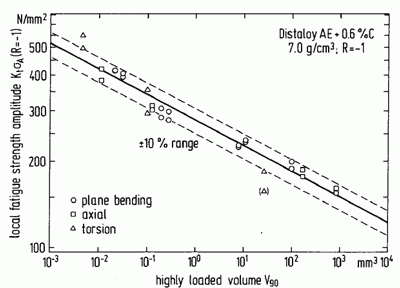Fatigue properties of high strength Powder Metallurgy structural part materials – Part 1
In part one of this exclusive review for ipmd.net, Dr David Whittaker reports on a presentation by Prof Paul Beiss, RWTH Aachen University, Germany, during the session on Materials for Automotive Applications.
It has long been recognised that generating a capability to serve markets for more highly stressed component applications is key to the PM structural parts sector’s ability to sustain growth rates in demand. Equally, it has also been long recognised that good knowledge on the fatigue performance levels of the materials that might serve such applications is a prime requirement as an input to the product design process.
From a PM material viewpoint, there is a need to understand the influence of factors such as density level on fatigue properties for a given material grade. For the fatigue design process, there is a need for data covering a range of loading modes (e.g. bend, axial, torsion), specimen sizes, mean stress levels and notch factors; unfortunately, available fatigue data for PM structural materials have largely been determined in a bending mode at zero mean stress (R = -1) and with un-notched standard-sized test pieces.
Fatigue testing is recognised to be an expensive business and measuring data for all possible candidate materials across all material and fatigue loading conditions would be prohibitive. Therefore, a viable “tool-kit” that could be used to predict this required broad range of fatigue information from a more limited set of actual test results would be welcome as a vital means of tackling this problem.
Fatigue behaviour of sintered steel containing 4% Ni, 1.5% Cu, 0.5% Mo and 0.6% C
A paper from P Beiss and A Zafari (RWTH Aachen University, Germany) and K Lipp and J Baumgartner (Fraunhofer LBF, Germany), has sought to develop such a tool-kit and has tested the developed methodology against published fatigue data for the most heavily researched PM grade in this context, the diffusion alloyed 4% Ni, 1.5% Cu, 0.5% Mo grade with a 0.6% C addition (designated FD-05N4C in ISO 5755 and FD-0405 in MPIF Standard 35).
Fatigue strengths for this material have been measured with various notched and unnotched specimen geometries comprising alternating and pulsating loading in axial, plane bending and torsion tests.

Fig. 1 Correlation between local fatigue strength and highly loaded
volume (As presented by P.Beiss, RWTH Aachen, Germay, at
PowderMet2011. Courtesy MPIF)
For each geometry and loading condition, the stress concentration factor Kt and the associated highly stressed volume (defined as the material volume exposed to stresses of at least 90% of the maximum principal stress) can be calculated by finite element analysis. From the nominal fatigue strength at 107 cycles and 50% probability of survival and the stress concentration factor, the locally endurable fatigue strengths can be calculated and correlated with the corresponding highly loaded volumes.
Fatigue strengths can be normalised to a standard density (e.g. 7.0 g/cm3) using a power law relationship with an exponent which, from experience, can be approximated as 5.
Within the range investigated, the density-normalised local strengths conformed well with a simplified 2-parameter Weibull distribution. Axial, plane bending and torsional fatigue strengths all then fit into a common narrow scatter band of about +/- 10% around a regression curve at constant stress ratio R (Fig. 1).

Fig. 2 Axial Haigh Diagram comprising compressive mean stresses
(As presented by P.Beiss, RWTH Aachen, Germay, at PowderMet2011.
Courtesy MPIF)
As a model component, a synchroniser hub was fatigue tested in torsion and was analysed by finite elements for highly loaded volume and the ratio between torque and the first principal stress in the tooth root of the outer splines, where such components fail. The fatigue strengths of the synchroniser hubs were fully predictable from the performance of laboratory test bars.
A functional relationship has been established between local pulsating and corresponding local fully reversed fatigue strength amplitudes for medium strength steels. The mean stress sensitivity for this group of steels can therefore be quite reliably estimated and the relationship between fatigue strength amplitudes and mean stresses is more or less linear within the stress ratio range -5
The authors proposed that the dependence of local endurable fatigue stresses on the associated highly loaded volume has the potential to become a universally applicable strength criterion for cyclically loaded components.
In order to apply the method universally, material behaviour must be explored for a wider span of stress ratios beyond R = -1 and R = 0. The authors recommend that component tests should be performed to confirm the reliability of the proposed approach and that a database should be established for the most common PM steels. FEM code providers should also be encouraged to include the capability for calculating highly stressed volume in their software.
> Part two
Author: Dr David Whittaker is a consultant to the Powder Metallurgy and associated industries. Contact +44 1902 338498 email: [email protected]
News | Articles | Market reviews | Search directory | Subscribe to e-newsletter





